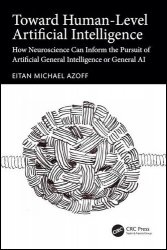Toward Human-Level Artificial Intelligence: How Neuroscience Can Inform the Pursuit of Artificial General Intelligence
- Добавил: literator
- Дата: 2-08-2024, 17:57
- Комментариев: 0
 Название: Toward Human-Level Artificial Intelligence: How Neuroscience Can Inform the Pursuit of Artificial General Intelligence
Название: Toward Human-Level Artificial Intelligence: How Neuroscience Can Inform the Pursuit of Artificial General IntelligenceАвтор: Eitan Michael Azoff
Издательство: CRC Press
Год: 2025
Страниц: 193
Язык: английский
Формат: pdf (true), epub
Размер: 14.2 MB
Is a computer simulation of a brain sufficient to make it intelligent? Do you need consciousness to have intelligence? Do you need to be alive to have consciousness? This book has a dual purpose. First, it provides a multi-disciplinary research survey across all branches of neuroscience and AI research that relate to this book’s mission of bringing AI research closer to building a human-level AI (HLAI) system. It provides an encapsulation of key ideas and concepts, and provides all the references for the reader to delve deeper; much of the survey coverage is of recent pioneering research. Second, the final part of this book brings together key concepts from the survey and makes suggestions for building HLAI. This book provides accessible explanations of numerous key concepts from neuroscience and Artificial Intelligence research, including:
The focus on visual processing and thinking and the possible role of brain lateralization toward visual thinking and intelligence.
Diffuse decision making by ensembles of neurons.
The inside-out model to give HLAI an inner "life" and the possible role for cognitive architecture implementing the scientific method through the plan-do-check-act cycle within that model (learning to learn).
A neuromodulation feature such as a machine equivalent of dopamine that reinforces learning.
The embodied HLAI machine, a neurorobot, that interacts with the physical world as it learns.
One important confession I wish to make at the outset: I use the term human-level AI (HLAI) in respect of machine intelligence that matches human intelligence – the same level as a human. But you won’t find a definition here of what I mean by human-level intelligence. As it is (mostly) humans reading this book, I will assume we all know what we mean by our intelligence then I can perhaps be forgiven the lack of definition. The same applies to the other widely used term, artificial general intelligence (AGI) or general AI – it suffers from the same lack of hard definition. And the reason there is no hard definition is first, that how intelligence is created, cracking the neural code, understanding how the brain works – the mission of this book – is currently unknown. And second, human intelligence has multiple dimensions (computational, mathematical, logical, emotional, social, artistic, and more) and this is an aspect beyond the scope of this book. Note: it will become clear in Part Three why I have avoided AGI in favor of HLAI as it allows useful labeling of variations.
This book concludes by explaining the hypothesis that computer simulation is sufficient to take AI research further toward HLAI and that the scientific method is our means to enable that progress. This book will be of great interest to a broad audience, particularly neuroscientists and AI researchers, investors in AI projects, and lay readers looking for an accessible introduction to the intersection of neuroscience and Artificial Intelligence.
Скачать Toward Human-Level Artificial Intelligence: How Neuroscience Can Inform the Pursuit of Artificial General Intelligence
Внимание
Уважаемый посетитель, Вы зашли на сайт как незарегистрированный пользователь.
Мы рекомендуем Вам зарегистрироваться либо войти на сайт под своим именем.
Уважаемый посетитель, Вы зашли на сайт как незарегистрированный пользователь.
Мы рекомендуем Вам зарегистрироваться либо войти на сайт под своим именем.
Информация
Посетители, находящиеся в группе Гости, не могут оставлять комментарии к данной публикации.
Посетители, находящиеся в группе Гости, не могут оставлять комментарии к данной публикации.
